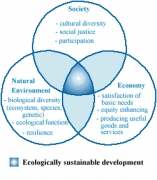d. continuing shortages of water;
e. reducing fish stocks;
f. increasing habitat destruction, particularly by land clearing;
g. rapid depletion of dwindling mineral and other resources;
h. detrimental visual and lifestyle impacts from continuous building works throughout the region;
i. increasing transport problems with parking and public transport availability;
j. increasing removal of green-space within the urban footprint, including the overall reduction of vegetation throughout the region because of greenfield development and the rezoning within the urban footprint to allow medium density development, with the consequential impact on visual amenity and on native animal and bird life; and
k. deteriorating social conditions, such as visual and acoustic privacy, adequacy of private open space, solar access, garage dominance, visitor parking and, importantly, the increase in opportunities for anti-social behaviours and crimes due to increased population density, increased anonymity, higher concentration of different social mixes and potential frictions.
Part D, Section 1, of the Draft South East Queensland Regional Plan 2009-2031 is devoted to it. The Plan, at p.32, quotes the goal of the National Strategy for Ecologically Sustainable Development, which is
"Development that improves the total quality of life, both now and in the future, in a way that maintains the ecological processes on which life depends".
Importantly, the Strategy endorsed by the Council of Australian Governments, defines ecologically sustainable development as:
‘using, conserving and enhancing the community's resources so that ecological processes, on which life depends, are maintained, and the total quality of life, now and in the future, can be increased'.
The Strategy specifies three core objectives for Australian governments to follow. These are to:
- enhance individual and community well-being and welfare by following a path of economic development that safeguards the welfare of future generations.
- provide for equity within and between generations.
- protect biological diversity and maintain essential ecological processes and life-support systems.
The Plan does not comply with the third core objective. Additionally, throughout the Plan there are clauses that allow sustainability to be overridden whenever population pressures arise.
The National Strategy for Ecologically Sustainable Development was prepared by the Ecologically Sustainable Development Steering Committee and
endorsed by the Council of Australian Governments December, 1992. Read the strategy here.
This article is based on Hackett gives his view on the new South East Queensland Plan available here in bayjournal.com.au.

 The Draft South East Queensland Regional Plan 2009-2031 adopts uncontrolled population growth, ignoring any consideration of a population cap for SEQ. Not to limit population growth is to accept that our lifestyles and environment will be destroyed irrevocably and that our water, mineral and other resources will be depleted sooner rather than later. Australian Bureau of Statistics (ABS) data shows that the population of SEQ is increasing at about 1.8 per cent per year; about 41% due to net overseas migration, 39% due to natural increase (the excess of births over deaths), and 20% attributable to net interstate migration.
The Draft South East Queensland Regional Plan 2009-2031 adopts uncontrolled population growth, ignoring any consideration of a population cap for SEQ. Not to limit population growth is to accept that our lifestyles and environment will be destroyed irrevocably and that our water, mineral and other resources will be depleted sooner rather than later. Australian Bureau of Statistics (ABS) data shows that the population of SEQ is increasing at about 1.8 per cent per year; about 41% due to net overseas migration, 39% due to natural increase (the excess of births over deaths), and 20% attributable to net interstate migration.